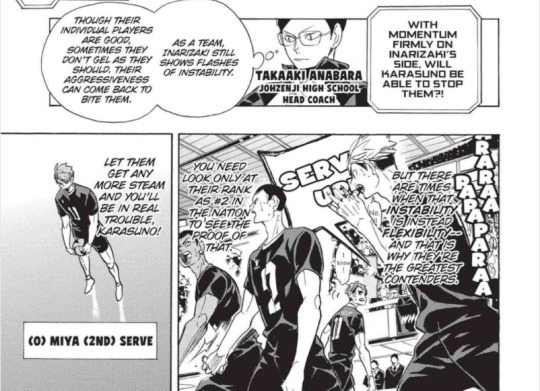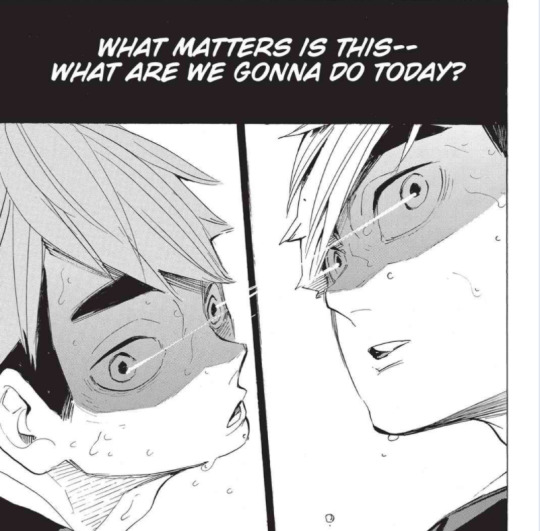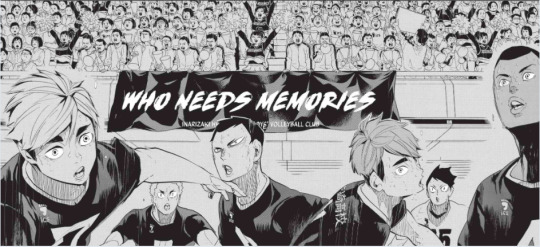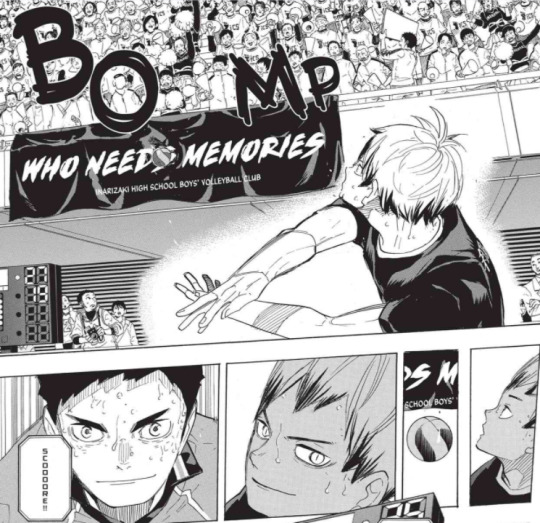#once again this has gotten so incredibly long i'm so sorry bdkkjgnnffb
Explore tagged Tumblr posts
Note
please talk more about the inarizaki banner and how it was used as a motif 🙏
first of all thank you SO MUCH for indulging me because I think about this banner all the time gdjfgkjd
second, have a look at @suckishima’s gifset! It’s a really great demonstration/summary of how it was used throughout the Inarizaki vs Karasuno match
i want to start by mentioning that there’s a really interesting difference in how the banner was used in the manga vs in the anime. The anime often cuts to Inarizaki’s cheer section, which is seated directly above the banner so the banner’s presence was made known to us since the very beginning of the game. But, it wasn’t given significance until episode 22. From this moment onwards, we start to see it in a new light:

However, in the manga, the banner was completely absent until the very end of chapter 280. Inarizaki’s coach explains what it means, and Riseki, Inarizaki’s pinch server, looks at it himself, but the readers are held back from feeling its full effect:



The core of this chapter is an explanation of what the banner means for Inarizaki and the twins:

Considering Atsumu and Osamu’s plays in particular: they pull off the freak quick attack Hinata and Kageyama have been uniquely using this whole series. They pull off a “reverse” version where Osamu sets to Atsumu. The attack isn’t completely reliable (because they do it without having practiced it first), but they still try it again and again. There are a handful of times when Atsumu jumps in front of the receiver and sets on the first touch, catching even his own teammates off guard. Atsumu is able to make sets count off of poor receives in general. They are constantly doing the unexpected and challenging themselves, every step of the way.

Now that we understand their personal philosophy, we are finally allowed to see the entirety of the banner:

This banner is great because it’s not just a philosophy the team holds but -- circling back to what Riseki learned -- it’s a mentality that can be good to have, a reflection of task focus that has been emphasized all throughout the series. It’s impossible not to make any sort of mistake. You can reflect on the game after it’s over but in this moment, what you can do today is to focus on the next point. Karasuno is down on themselves because they fail to score a point off of Hinata’s receive, until Hinata tells them, “You’d better be watching when I do it again!”. They haven’t lost yet; there’s always a next time.
Next is a really interesting exchange between Kita and Daichi. Kita expresses a dislike of the banner because it doesn’t mesh well with his personal philosophy. He is a much more conservative player than those he watches over. He says after the game that he would prefer if the twins didn’t try out new things in a game without having practiced them first. He says, “The road that brought us here doesn’t just stretch out in front of us. Challenging yourself is one thing -- being reckless is another.” The twins try the reverse minus tempo quick again but miss, and Kita is right there to save the ball.
There’s another battle of concepts to challenge Kita’s outlook on what the banner means. Karasuno constantly does four- or five-man synchro attacks, making almost everyone a decoy in an attack and leaving next to no one to follow up on a potential block. Kita criticizes this as he sees Daichi make his approach among everyone else -- “In the Shiratorizawa game, they didn’t pass to the back row on this attack a single time ... we know you aren’t gonna get the ball, so what’s the point? Why abandon your post as backup to your teammates just to be a decoy?”
Kageyama sets the ball to Daichi, Daichi thinks, “I’m not just here to play defense and back up my teammates. All of us are on this court to score.” and his spike bounces off of Kita’s arms and into the Inarizaki banner.

It almost plays out like a conversation.
There’s another subtle yet deliberate use of the banner at the very end of the game: Tsukishima looks at it before his serve and smirks. Aran just barely receives it and thinks, “Where the heck did that come from?! That glasses kid has been all about the ‘just get it in’ serve until now!”
The banner is shown one more time with the last point, when the twins attempt a back row minus tempo quick set that they have never done before, and they are blocked by the players who are most familiar with it, who know perfectly well that the unexpected is not invincible.

Thematically the banner is a great fit with the motifs of food, hunger, and growth presented all throughout this match. I especially like how it plays into Kita’s monsters’ ball speech, referring to the Miya twins and Kageyama and Hinata, who have been paralleled to each other for the entire match.
On Hinata: “Even when you’re dead tired, even when everything hurts and you just want to stop ... The drive ... to take one more step forward.” and “He plays volleyball like I eat my food”.
and on Kageyama: “Who is this kid? Where’d sweet lil Mr. Goody Two-Shoes go? What happened in the few weeks since camp?”
While they have not directly been shown along with the banner like the Miyas, it’s a really nice underlying statement to their growth and to their character, as both the banner and the payoffs to their respective training camp arcs have been focused on in this match. They always look to run ahead and challenge themselves but there’s an importance in learning from their mistakes and keeping a balance.
When you consider it in the story overall, “WHO NEEDS MEMORIES” is one of the many expressions that reminds you not to dwell on mistakes or fall into regret, because yesterday is food that has all gone towards nourishing you and building up your muscle. What is important is not necessarily your past, but how you stand back up from a fall and what you decide to do today. There is always a new you to nurture.
#once again this has gotten so incredibly long i'm so sorry bdkkjgnnffb#janina reads hq!!#hq!!#inarizaki#karasuno#ask#anonymous#food becomes muscle
120 notes
·
View notes